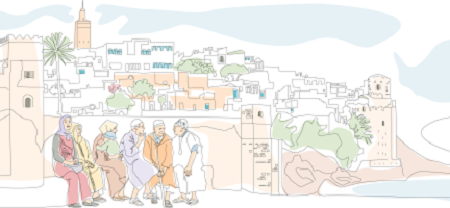HIC-HLRN at 3rd Arab Land Conference: Restoring HLP Rights across the Region

Morocco hosted the Third Arab Land Conference in Rabat from 18 to 20 February 2025. That round of the important gathering of practitioners organized by the Ministry of National Territory and Urban Planning, Housing, and City Policy , UN-Habitat, Global Land Tool Network (GLTN) and the Arab Land Initiative, in partnership with the League of Arab States, UNESCWA, UNECA, the German Ministry of International Cooperation (BMZ), the Netherlands Enterprise Agency (RVO), Land Portal, International Land Coalition, World Bank and Morocco land-sector stakeholders.
At the First Arab Land Conference (2018), Joseph Schechla (HIC-HLRN) enumerated the Arab states’ displaced and refugee population at more than 33.4 million eligible for housing, land and property (HLP) restitution. In 2022, GLTN/UN Habitat published a rounded estimate of 40 million displaced persons across the region. At the 3rd Arab Land Conference, Schechla presented current available figures over 49.8. million. These persons in the Arab states affected by internal demographic-manipulation programs, external invasion and occupation. These numbers do not include persons displaced in the context of development projects or other forms of local forced evictions. However, the 2025 figures also include almost 3.4million displaced by climate change. (See “A Regional Approach to Remedy Displacement?” in this issue of Land Times.)
This upward trend marks 38% more unremedied displacement with HLP restitution rights pending fulfilment. Even without the ominous rise with the climate displaced, 42.6 million, a net 27% increase from conflict, war and occupation. Reduction in numbers in some countries with returnees and HLP-restitution programs (e.g., Iraq, Syria) were offset by new conflict-displaced others (e.g., Palestine and Sudan). With multiple forces and accumulating costs to victims, no regional HLP-restitution discourse is audible. However, other effective regional approaches precede, as in the Balkans and Africa’s Great Lakes Region, which latter incorporated the Pinheiro Principles on HLP restitution.
Muhammad al-Yatari, of Arab Youth Sustainable Development Network (Yemen), offered [via video] the findings of research and consultations with relevant Yemeni actors on the impacts of land dispossession in the context of (1) political corruption and tribal rule before 2011 and (2) the impact of the current conflict. After diagnosing the complex crisis and its impacts, Muhammad set out conditions needed to restore displaced Yemenis’ HLP in the pursuit of restorative justice.
That remedial outcome requires surmounting security legal and administrative challenges, he explained, to realize women’s rights, generate employment and restore infrastructure. All this is needed amid unequitable customary practices, degraded land and environment, climate change, enduring conflict, and institutional and governance breakdown. Nonetheless, he urged reviving transitional justice processes and activating the land registry. He recommended an affected-persons focused recovery and reconstruction plan that enables lively civic participation and entrepreneurship, engaging youth within a normative framework that promotes women’s rights and leadership, does justice to marginalized communities, pursues food sovereignty, and balances rural and urban development with the maximum of available resources.
Helez Fateh Abdelaziz, representing Insight (Syria), [via video] summarized displacement and HLP issues in northern Syria and Iraq. She categorized both types of dispossession during the 14 years of conflict in Syria, and the challenges facing returnees. She focused especially on the multiple discrimination and disadvantages afflicting women in displacement and return, often lacking legal support, or needed civil documentation.
Helez explained how Turkish militias’ occupation of the infrastructure has deprived northern Syria regions of their vital water resources, coupled with their ongoing home confiscations, land grabs and ensuing displacement. On Iraq, she referred to lessons learned from UN Habitat’s HLP-restitution practice in Sinjar.
Ahmed Mansour Ismail (HIC-HLRN) provided the human-rights framework for actions toward implementing the represented organizations’ common recommendations. He shared the history of HLP-restitution programs across the region, as well as a journey through norm and standard setting. Ahmed then demonstrated how the norms could be operationalized in human rights-grounded eviction-and-displacement monitoring, which still needs to develop further across the region.
Moroccan hosts censored this event and forced its cancellation because a table featured in Mr. Schechla’s PPT presentation cited refugees from Western Sahara.
Image: Artwork from the Third Arab Land Conference. Source: Global Land Tool Network.
|